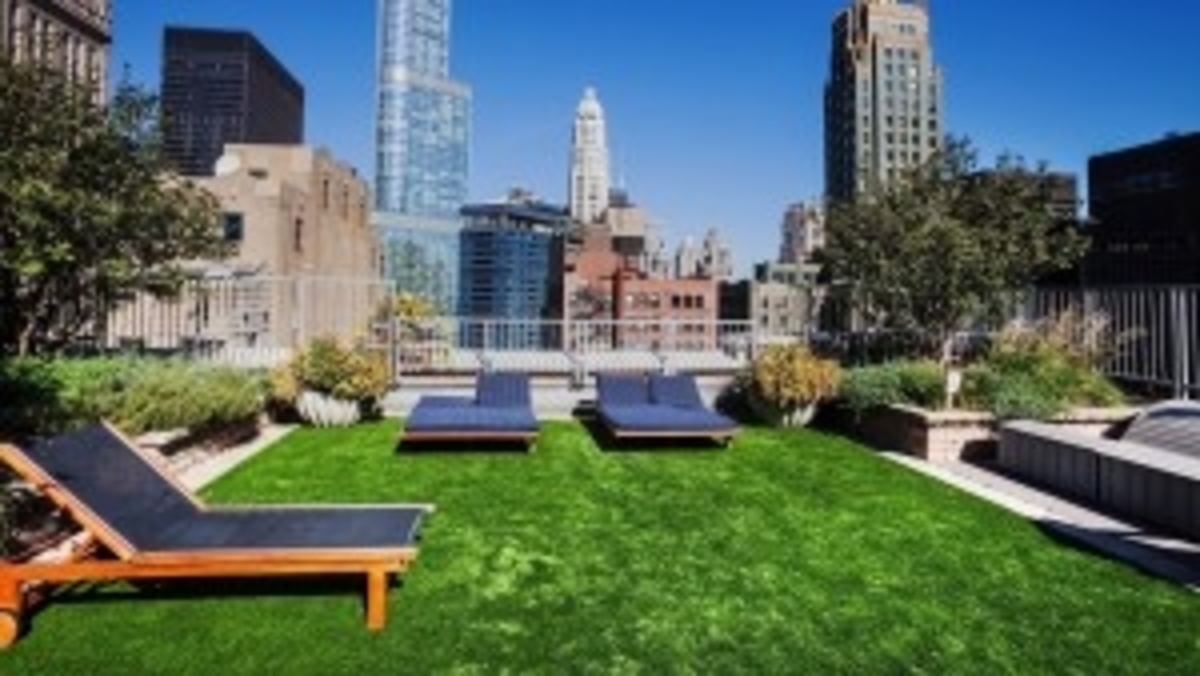6 Reasons to Invest in Green Roofs

A green roof — also known as a living roof, eco-roof, vegetated roof and rooftop garden — has economic and environmental benefits that can offset its initial cost and required maintenance.
This “living roof” is an extension placed above a typical roof surface. A green roof can also be at ground level over an underground built structure.
The components of a green roof include: a root repellant barrier, a drainage system, filter cloth, a lightweight growing medium and plants. All of these are placed above the waterproof membrane of a flat or shallow-pitched roof surface. An edge treatment of metal or plastic is typically installed to separate the vegetated area from the edge of the roof.
Instead of soil, the growing medium comprises shale and/or slate (approximately 50%) that is super-heated to produce a lightweight, engineered mixture that captures the nutrients in rain to sustain the plants. Other materials in the growing medium include sand, clay and sanitized compost. The drainage layer holds the rainwater for plants to absorb. Any overflow runs under the assembly to the roof drains.
The components can be installed individually or in a modular system of trays that are pre-grown at a nursery.
Potential Benefits of Green Roofs
- Reduce stormwater runoff: Runoff carries trash, pollutants, fertilizers and pet waste into rivers and streams, and raises nutrient loads that damage aquatic life. More than two dozen major U.S. cities have regulations to reduce runoff through green infrastructure, including green roofs, that include monetary incentives such as rebates, cost-sharing and tax credits.
- Combat the urban heat island effect — e.g., why standing on the sidewalk next to a high-rise in summer is uncomfortable compared to walking through a forest. In fact, Chicago City Hall’s award-winning green roof averages 7 degrees cooler than surrounding roofs, and as much as 30 degrees cooler in the summer.
- Reduce utility costs: The plants and growing medium serve as an insulator to moderate indoor temperatures in both summer and winter. Climate zone, siting and building configuration affect the extent of energy savings, which can be in excess of 70% in some buildings.
- Improve air quality: The rooftop plants trap particulates from chimneys and vehicle exhaust. In combination with the growing medium, the plants also lower noise levels, reduce electromagnetic radiation and suppress fire potential.
- Protect the roof surface: This can extend the life of the membrane and reduce waste through fewer replacements.
- Improve well-being: Multiple studies have found that plantings and gardens, especially in urban areas, can improve people’s physical, mental and psychological well-being. Even if the green roof is experienced only visually through the windows, people can have lower stress and improved job performance.
Green roofs are more expensive than conventional roof finishes and have ongoing maintenance requirements. Yet in comparison to the costs of building new and replacing old gray infrastructure (underground piping and storage) for runoff reduction alone, the costs of green roofs and other green infrastructure technologies can be much less.
It is important to weigh the benefits, construction costs and maintenance requirements to determine if a green roof makes sense for your next project.
Planning a Green Roof
First, why create a green roof, and what is its intended use? Is it to meet a local stormwater regulation, to create an amenity space, to grow food, to provide habitat for urban wildlife? Depending upon its purpose, design and planning elements will follow and align with its use.
Green roofs come in two types: extensive and intensive.
Extensive green roofs include:
- A growing medium of less than 6 inches deep. Because they’re shallower, they cost less to install and weigh less.
- Almost exclusive installation of sedums — low-growing succulents with lateral root systems that are extremely hardy in both wet and dry conditions
Intensive green roofs include:
- A growing medium of more than 6 inches deep, which can support a wider range of plants, including grasses and perennials
- Greater cost for labor and materials, and more maintenance, because of increased weight
Engineering of the roof structure must account for added weight. A 4-inch extensive green roof typically adds 30 pounds per square foot to the roof load capacity; however, intensive green roofs may add 60 or more pounds per square foot.
Defining access to the roof in the design process is critical for the construction phase and future maintenance needs as well. Contractors need to plan for delivery, staging, and transport of materials to the rooftop, as well as rooftop safety provisions for installation.
This post was adapted from an article on Best in American Living. Read the full article here. Peter Ensign, LEED AP BD+C, CBLP, GRP, is principal of Divergence LLC Ecological Services and Green Building. He is a recognized expert in the design, construction and maintenance of green building systems and green infrastructure.
